Lyndon B. Johnson Worksheets
Do you want to save dozens of hours in time? Get your evenings and weekends back? Be able to teach about Lyndon B. Johnson to your students?
Our worksheet bundle includes a fact file and printable worksheets and student activities. Perfect for both the classroom and homeschooling!
Resource Examples
Click any of the example images below to view a larger version.
Fact File
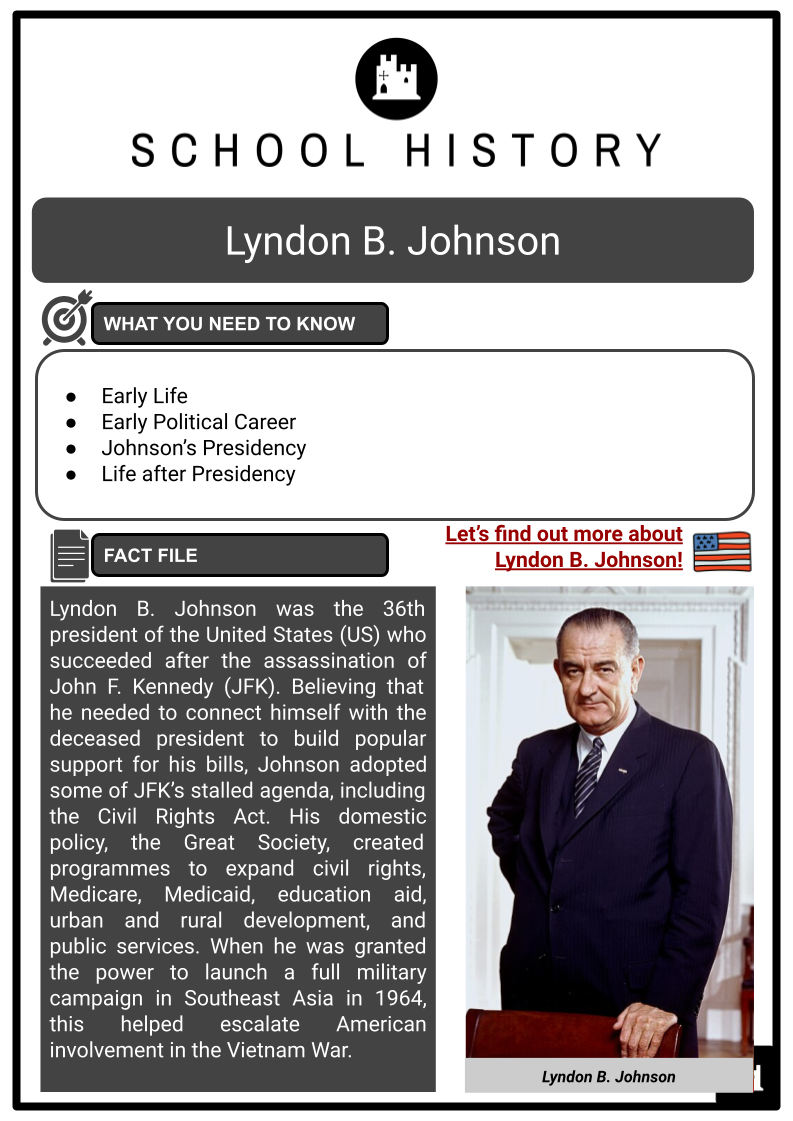
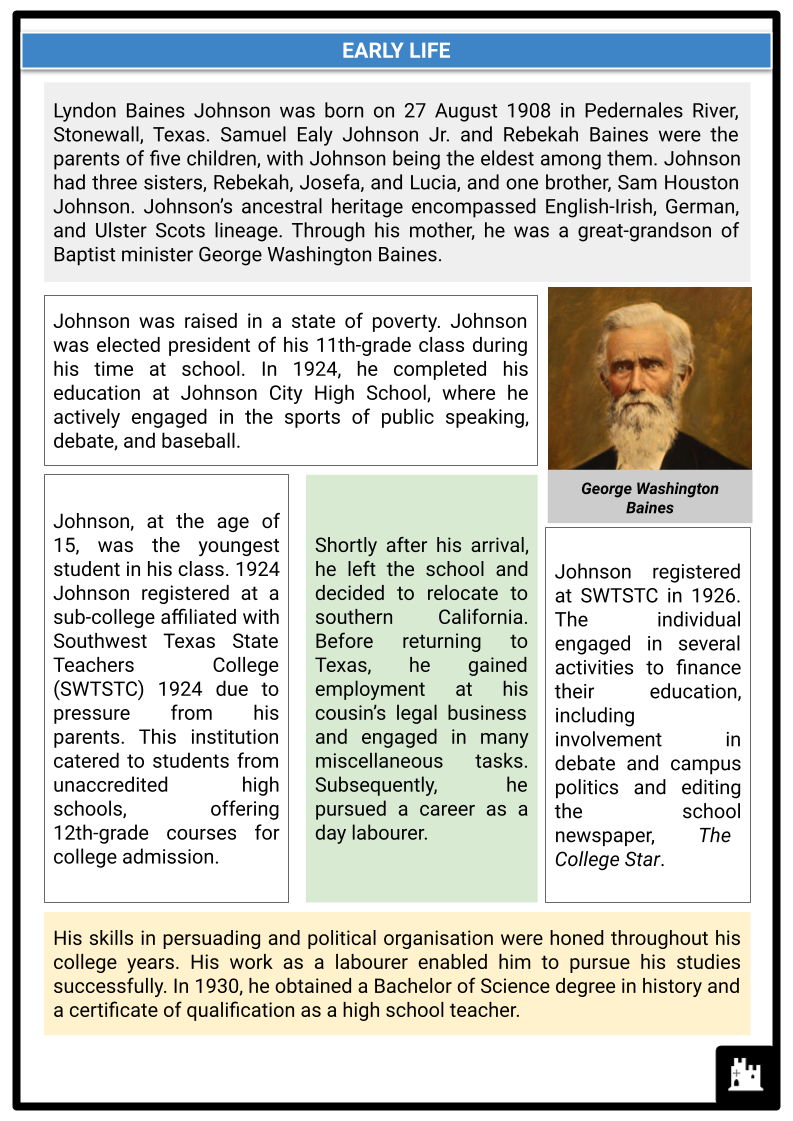
Student Activities
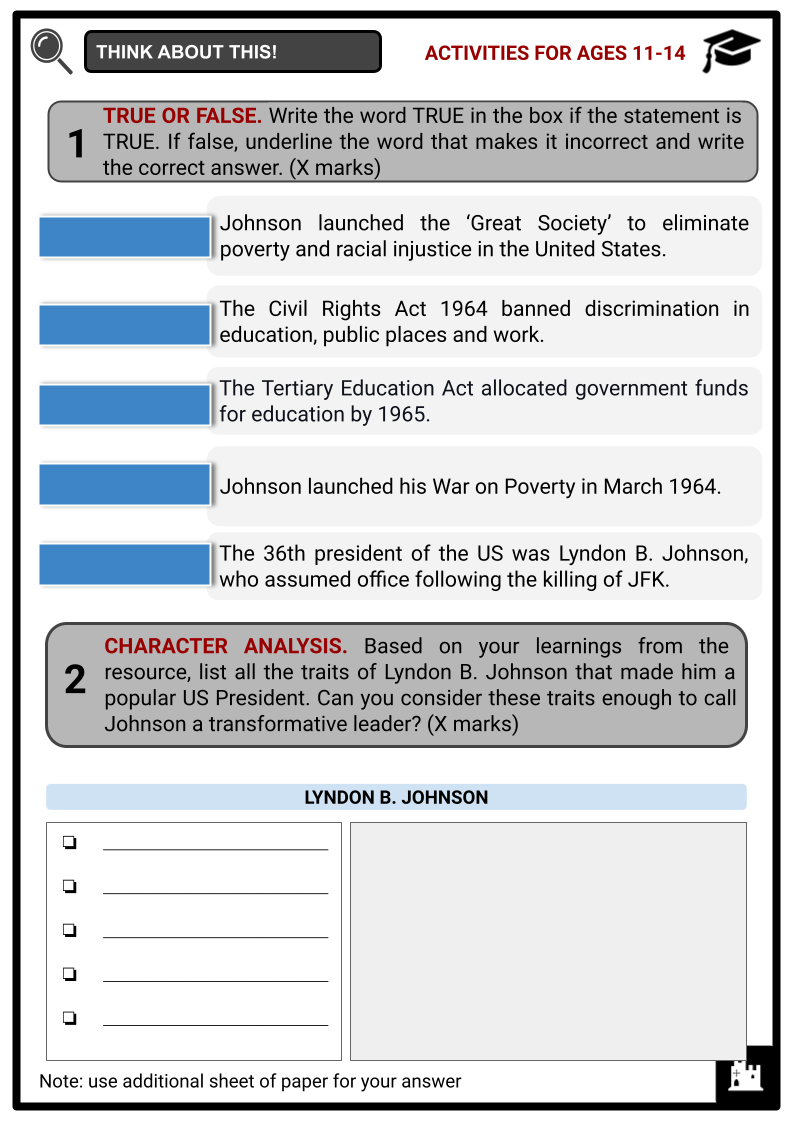
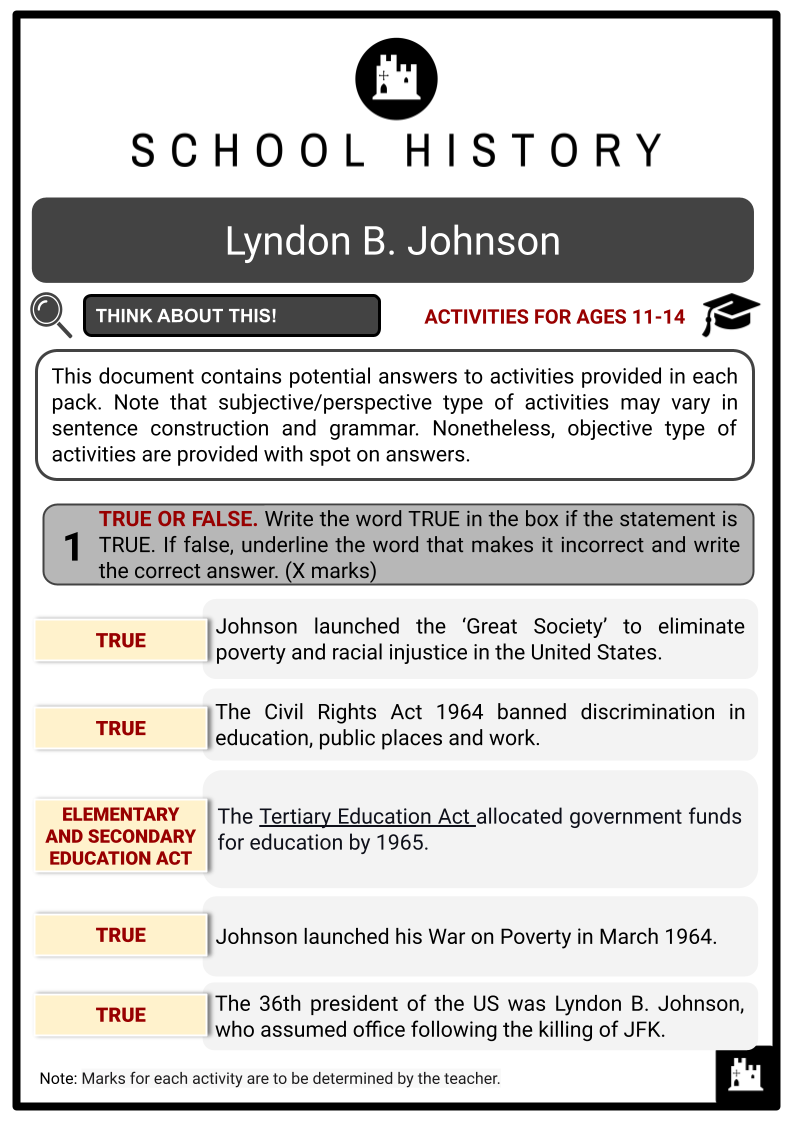
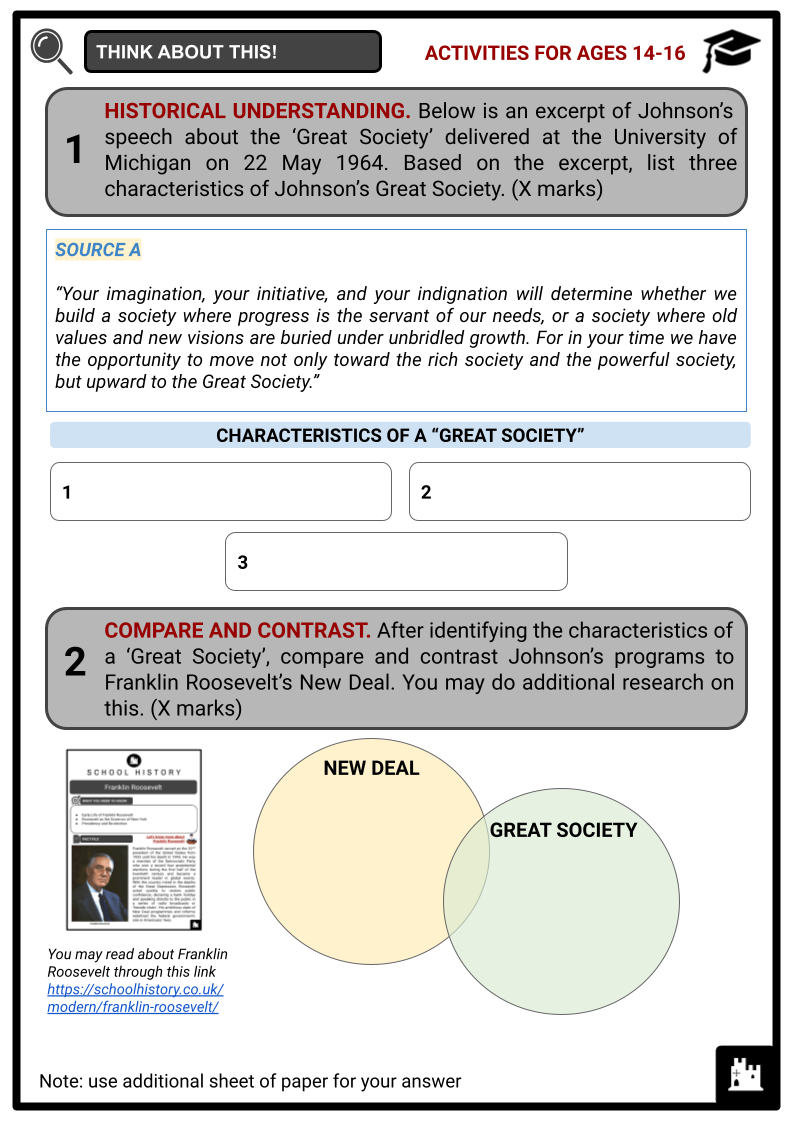
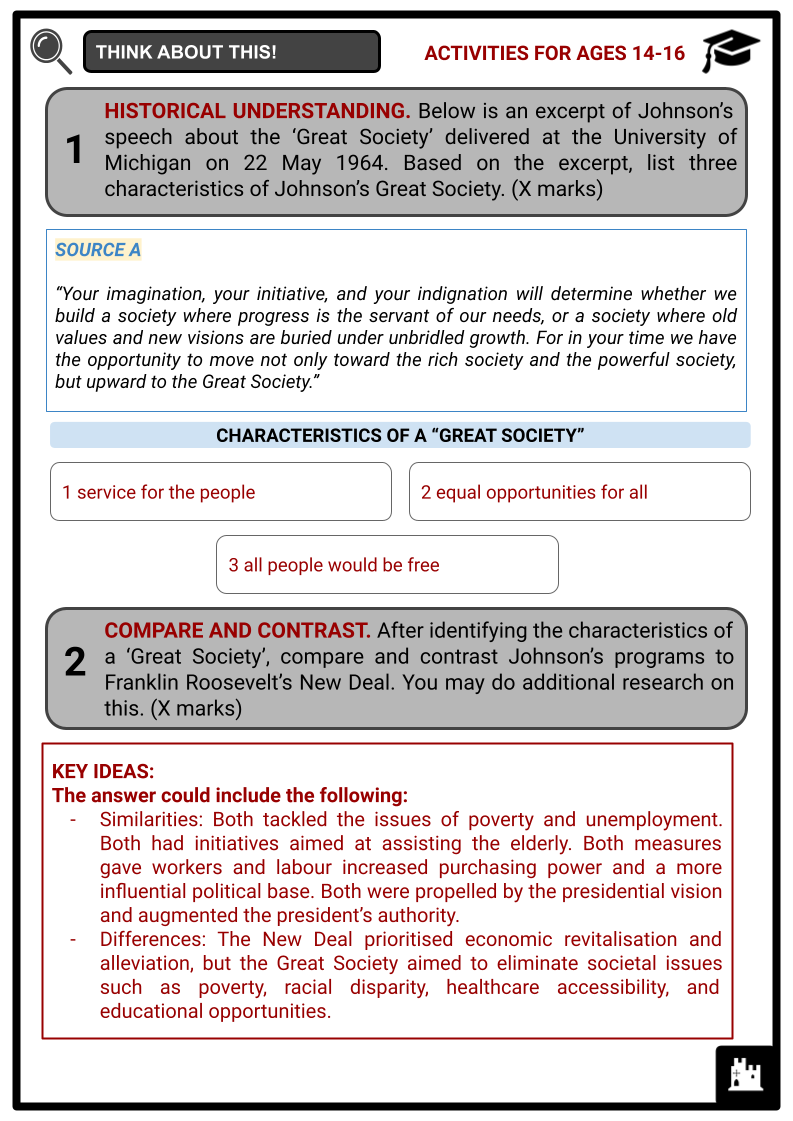
Summary
- Early Life
- Early Political Career
- Johnson’s Presidency
- Life after Presidency
Key Facts And Information
Let’s find out more about Lyndon B. Johnson!
Lyndon B. Johnson was the 36th president of the United States (US) who succeeded after the assassination of John F. Kennedy (JFK). Believing that he needed to connect himself with the deceased president to build popular support for his bills, Johnson adopted some of JFK’s stalled agenda, including the Civil Rights Act. His domestic policy, the Great Society, created programmes to expand civil rights, Medicare, Medicaid, education aid, urban and rural development, and public services. When he was granted the power to launch a full military campaign in Southeast Asia in 1964, this helped escalate American involvement in the Vietnam War.
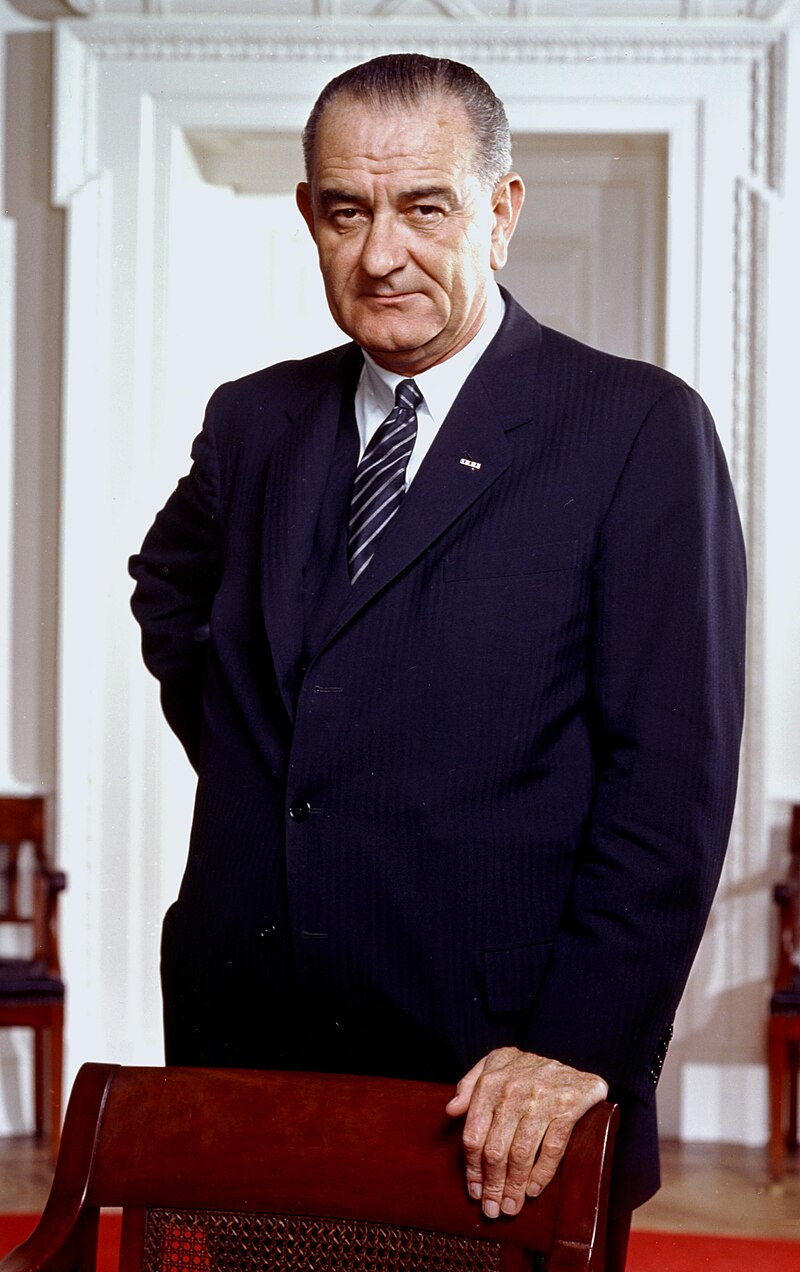
EARLY LIFE
- Lyndon Baines Johnson was born on 27 August 1908 in Pedernales River, Stonewall, Texas. Samuel Ealy Johnson Jr. and Rebekah Baines were the parents of five children, with Johnson being the eldest among them. Johnson had three sisters, Rebekah, Josefa, and Lucia, and one brother, Sam Houston Johnson. Johnson’s ancestral heritage encompassed English-Irish, German, and Ulster Scots lineage. Through his mother, he was a great-grandson of Baptist minister George Washington Baines.
- Johnson was raised in a state of poverty. Johnson was elected president of his 11th-grade class during his time at school. In 1924, he completed his education at Johnson City High School, where he actively engaged in the sports of public speaking, debate, and baseball.
- Johnson, at the age of 15, was the youngest student in his class. 1924 Johnson registered at a sub-college affiliated with Southwest Texas State Teachers College (SWTSTC) 1924 due to pressure from his parents. This institution catered to students from unaccredited high schools, offering 12th-grade courses for college admission.
- Shortly after his arrival, he left the school and decided to relocate to southern California. Before returning to Texas, he gained employment at his cousin’s legal business and engaged in many miscellaneous tasks. Subsequently, he pursued a career as a day labourer.
- Johnson registered at SWTSTC in 1926. The individual engaged in several activities to finance their education, including involvement in debate and campus politics and editing the school newspaper, The College Star.
- His skills in persuading and political organisation were honed throughout his college years. His work as a labourer enabled him to pursue his studies successfully. In 1930, he obtained a Bachelor of Science degree in history and a certificate of qualification as a high school teacher.
EARLY POLITICAL CAREER
- Following his victory in a special election in 1931, Richard M. Kleberg successfully elected Johnson as his legislative secretary to represent Texas in the US House of Representatives. This event signified Johnson’s official foray into politics. Johnson gained the job based on the endorsement of his father and state senator Welly Hopkins, whom he had campaigned for in 1930.
- Kleberg showed less enthusiasm for the routine responsibilities of a Congressman, opting instead to assign them to Johnson. Following Franklin D. Roosevelt’s victory in the 1932 United States presidential election, Johnson professed unwavering endorsement of Roosevelt’s New Deal, a comprehensive framework encompassing a range of initiatives, public infrastructure endeavours, fiscal restructuring, and regulatory measures implemented by Roosevelt.
- During this particular era, Johnson assumed the position of speaker for a small group of Congressional aides, whereby he fostered the development of Congressmen, newspaper journalists, and lobbyists.
- Johnson assumed leadership of the Texas National Youth Administration in 1935, granting him the authority to provide publicly funded educational and employment prospects for the youth. He stepped down two years later to pursue a career in Congress.
House of Representatives
- In 1937, following the death of James P. Buchanan, a congressman who had served for thirteen terms, Johnson effectively participated in a special election for the 10th congressional district of Texas. This area encompassed Austin and the adjacent hilly region. He campaigned on a New Deal agenda and received substantial support from his wife. From 10 April 1937 to 3 January 1949, he held the position of a US Representative.
- Roosevelt saw Johnson as a valuable political partner and a reliable source of information, specifically about the internal political dynamics of Texas and the diplomatic strategies employed by Vice President John Nance Garner and House Speaker Sam Rayburn.
- Following his appointment, Johnson was promptly designated to the Naval Affairs Committee. He dedicated his efforts to implementing rural electricity and other enhancements within his district.
- Johnson directed the projects towards contractors he was familiar with, such as Herman and George Brown, who provided significant financial support for Johnson’s future professional endeavours.
Military Member
- On 21 June 1940, Johnson assumed the position of lieutenant commander within the United States Naval Reserve. During his tenure as a US representative, he was summoned to active duty three days following the Japanese assault on Pearl Harbour in December 1941. The initial directive assigned to him entailed the provision of teaching and training at the Office of the Chief of Naval Operations located in Washington, DC.
- In the Southwest Pacific, Roosevelt designated Johnson as a member of a three-person survey team. In Australia, Johnson was under the supervision of General Douglas MacArthur. Johnson, along with two commanders from the United States Army, proceeded to the 22nd Bomb Group base, where they were tasked with the perilous job of conducting an airstrike on the Japanese airbase located in Lae, New Guinea.
- Johnson offered his services as an observer for an airstrike on New Guinea on 9 June 1942. According to MacArthur’s recommendation, Johnson was awarded the Silver Star for his valour in action. The citation highlights that Johnson’s aircraft encountered mechanical issues during the operation, resulting in a failure to reach its intended destination.
- Johnson was awarded the American Campaign Medal, the Asiatic-Pacific Campaign Medal, the World War II Victory Medal, and the Silver Star. On 17 July 1942, he was relieved of his active duty duties. Nevertheless, he continued his service in the Navy Reserve. Subsequently, on 19 October 1949, he was advanced to the rank of commander, with his promotion taking effect on 2 June 1948. On 18 January 1964, he tendered his resignation from the Navy Reserve.
Johnson in Senate
- Johnson was reelected to the Senate in 1948 after serving six terms in the House. In 1953, he assumed the position of the youngest Minority Leader in the Senate’s history. Subsequently, in the subsequent year, following the Democrats’ victory, he was elected as the Majority Leader.
- During his tenure in the Senate, Johnson gained recognition among his peers for his notable achievements in cultivating relationships with senior senators, particularly Senator Richard Russell, a Democrat hailing from Georgia.
- Senator Russell had a prominent position as the leader of the Conservative coalition and was widely regarded as one of the most influential figures in the Senate.
- Johnson proceeded to cultivate Russell’s favour akin to his previous approach of being close to Speaker Sam Rayburn, securing his pivotal backing within the House.
- Johnson was designated as a member of the Senate Armed Services Committee and played a significant role in the establishment of the Preparedness Investigating Subcommittee in 1950. He assumed the role of chairman and carried out inquiries into defence expenditures and effectiveness.
- The committee’s studies further emphasised the necessity for changes, although the Truman administration partially implemented them. Following the 1950 general elections, Johnson was appointed as the Senate Majority Whip in 1951, serving under the leadership of Ernest McFarland of Arizona, who had recently assumed the position of Majority Leader. Johnson held this role from 1951 to 1953.
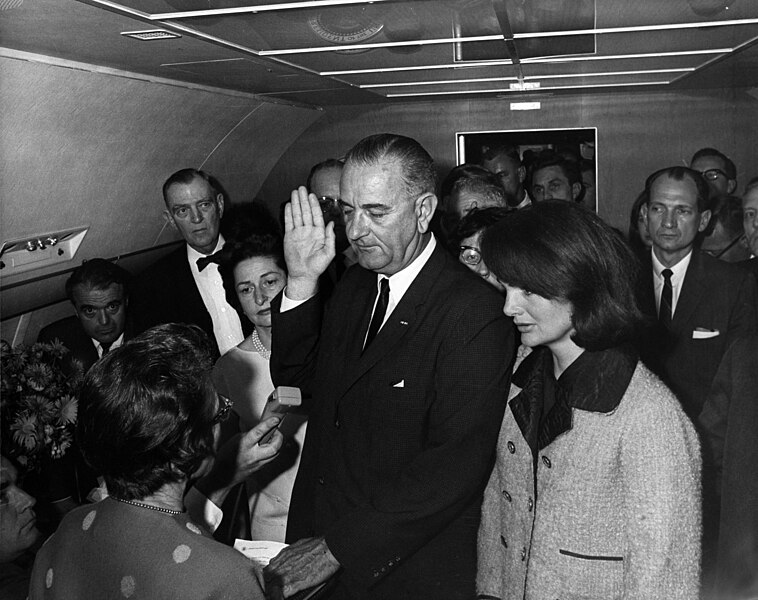
JOHNSON’S PRESIDENCY
- Johnson was elected Vice President in the 1960 campaign, serving as JFK’s running mate. Johnson assumed the presidency on 22 November 1963, following the assassination of Kennedy. While many Americans were grieving the death of JFK, Johnson took advantage by pushing through some of Kennedy’s agenda, including tax cuts and the Civil Rights Act.
- Among his initial moves as president were the introduction of the Office of Economic Opportunity and the Economic Opportunity Act, which aimed to break the poverty cycle by providing further education and skill-based programmes.
- In March 1964, Johnson initiated his War on Poverty by introducing the following:
- The Community Action programme that would enable local communities to deal with poverty
- The recruitment and training of American volunteers to serve in poverty-stricken communities
- Employers were given loans and guarantees if they offered jobs to the unemployed.
- Farmers were given funds to buy land and establish agricultural co-ops.
- Unemployed parents were supported as they entered the workforce.
The Great Society
- In 1964, health safety nets for America’s most vulnerable, the poor and the elderly, were provided. Medicare-covered physician and hospital costs for the qualified elderly, while Medicaid provided government cash assistance to the qualified poor.
- By 1965, federal funding for education was appropriated through the Elementary and Secondary Education Act. It specifically provided funds for school districts and covered preschool programmes, school libraries, textbooks and special education services.
- From 1964 to 1965, President Johnson launched a set of domestic policies that aimed to eliminate poverty and racial injustice in the United States. He coined it the ‘Great Society’. To ensure success among young Americans, Project Head Start was launched by President Johnson to be led by politician and activist Sargent Shriver.
- Along with a team of child development experts, the project launched an eight-week summer for 500,000 children aged three to five. In addition, President Johnson also signed the National Endowment for the Arts and Humanities, which funded and supported artists, libraries, public archives and galleries.
Initiatives included in the Great Society
Health:
- The Social Security Act authorised Medicare in 1965, providing federal funding to cover the medical costs of many older Americans.
- In 1966, the Medicaid programme was created for people of all ages.
Education:
- The Higher Education Act of 1965 provided increased federal aid to universities, established a Teacher Corps and produced scholarships.
Housing:
- The Housing and Urban Development Act of 1965 provided rehabilitation grants and rent subsidies to low-income households.
- In 1966, the Demonstration Cities Act was created to renovate neighbourhoods.
Welfare:
- In 1967, Social Security Amendments were passed that guaranteed better coverage and ampleness of social security benefits.
- The Food Stamp Act of 1964 made the Food Stamp Program permanent.
Environment:
- Johnson’s administration enacted multiple laws aimed at conserving resources, including the Clean Air Act of 1963, the Water Quality Act of 1965, the Solid Waste Disposal Act of 1965, the Endangered Species Preservation Act of 1966, and the National Environmental Policy Act of 1969.
Johnson’s role in passing Civil Rights legislation
- On 3 April 1963, Martin Luther King Jr, one of the most prominent leaders in the civil rights movement, together with the Southern Christian Leadership Conference, led a campaign against racial discrimination in Birmingham, Alabama. Known as the Birmingham campaign, it was a nonviolent protest with tactics developed with the help of Reverend Wyatt Tee Walker.
- African-American students also participated in the campaign wherein they occupied public spaces, engaged in sit-ins and violated racially unjust laws. The Birmingham campaign drew much controversy as the Birmingham Police Department, led by Eugene’ Bull’ Connor, responded with force using high-pressure water jets and police dogs. It lasted until 10 May 1963, and King, along with other African Americans, was arrested.
Civil Rights Act 1964
- While many Americans were grieving the death of JFK, Johnson took the opportunity to push through some of Kennedy’s agenda, including tax cuts and the Civil Rights Act. He had been a supporter of civil rights since the mid-1950s, being one of only a few Southern politicians who supported the Supreme Court’s ruling in the Brown case of 1954, which ruled segregated schools unconstitutional. He thought racism was ‘un-American’ and damaged the country’s image abroad. He also wanted to pay tribute to JFK after his assassination by getting the Civil Rights Bill signed into law.
- Johnson signed the Civil Rights Act in front of television cameras in July 1964. The law banned discrimination in education, public places and work, made the Jim Crow laws illegal and set up an Equal Opportunities Commission to investigate discrimination.
- Following the Civil War, constitutional amendments were passed that abolished slavery, gave formerly enslaved people citizenship and granted the right to vote to all men, regardless of race. Despite these amendments, African Americans continued to experience discrimination and segregation in many forms.
- The Civil Rights Act was signed on 3 July 1964. It ended racial segregation in public places and banned employment discrimination based on religion, sex, colour, and race.
- Under the 1964 Civil Rights Act, African Americans as a minority would not be segregated and discriminated against in any public places, including parks, theatres, restaurants, courthouses and others.
- They would also not be denied any services based on their colour. Moreover, the act also amassed sufficient funds for anti-discriminatory programmes, especially in assisting school desegregation.
Voting Rights Act 1965
- On 7 March 1965, peaceful participants in a Selma to Montgomery march for voting rights were attacked by Alabama troopers with whips, tear gas and nightsticks. The march was a series of three protests along the 54-mile (87km) highway from Selma, Alabama, to Montgomery, the state capital.
- The march was a nonviolent protest regarding African-American citizens’ constitutional right to vote in Alabama and other Southern states. These states had maintained a series of laws, such as the literacy test, which repressed African-American suffrage.
- Various groups, such as the Dallas County Voters League (DCVL), Student Nonviolent Coordinating Committee (SNCC), and King’s Southern Christian Leadership Conference (SCLC), organised and participated in the march. Even US President Lyndon B. Johnson strategised with King to monitor the event and plan a bill about the issue.
- What was not anticipated was an attack by state troopers on 7 March 1965 with whips, tear gas and nightsticks. The assault came to be known as Bloody Sunday. One of the organisers, Amelia Boynton, was beaten unconscious, and journalists published the offence. Another victim of the violence was a Unitarian Universalist minister from Boston, James Reeb. He was murdered at the second march on 9 March.
- The violence that erupted at the march brought public outrage. On 15 March 1965, Johnson held a televised joint session of Congress asking for the passage of a voting rights bill, known as the Voting Rights Act of 1965, which would benefit African Americans. At the third march, on 21 March, Alabama Governor George Wallace refused to protect the peaceful marchers. Johnson retaliated by protecting them with 1,900 members of the Alabama National Guard under the federal command, federal marshals and several FBI agents. On 24 March, the protesters reached Montgomery.
- The route they took has been designated as a US National Historic Trail known as the ‘Selma To Montgomery Voting Rights Trail’. On 6 August 1965, the Voting Rights Act became law.
LIFE AFTER PRESIDENCY
- Following his departure from the office in January 1969, President Johnson returned to his residence in Stonewall, Texas, escorted by Harry J. Middleton, a former adviser and speechwriter. Johnson grudgingly supported Democratic nominee George McGovern, a senator from South Dakota, during the 1972 presidential election.
- McGovern had consistently opposed Johnson’s foreign and defence policies. Johnson experienced an episode of angina in March 1970 and was transported to Brooke Army General Hospital in San Antonio. Johnson experienced a myocardial infarction in April 1972.
- His cardiac condition deteriorated dramatically, prompting a recommendation for surgery. Johnson experienced his ultimate cardiac arrest in his bedroom on 22 January 1973.
- The medical professionals made an effort to revive Johnson, and subsequently, he was transported via flight to San Antonio International Airport, with the intended destination being Brooke Army Medical Centre. Nevertheless, upon his arrival at the airport at 4:33 pm, cardiologist and Army colonel George McGranahan declared him deceased. Johnson’s age was 64.
Frequently Asked Questions
- Who was Lyndon B. Johnson?
Vice President Lyndon B. Johnson became the 36th President of the United States, serving from 1963 to 1969 after assuming the presidency after the assassination of President John F. Kennedy.
- What were Lyndon B. Johnson's major accomplishments as president?
Johnson's presidency is marked by significant legislative achievements, including the passage of the Civil Rights Act of 1964, the Voting Rights Act of 1965, and the establishment of Medicare and Medicaid. He also launched the "War on Poverty" programmes, which included initiatives like Head Start and the Economic Opportunity Act.
- What was Lyndon B. Johnson's stance on the Vietnam War?
Johnson escalated U.S. involvement in the Vietnam War, which began during the Kennedy administration. His administration significantly increased the number of American troops deployed to Vietnam, leading to widespread protests and controversy.
